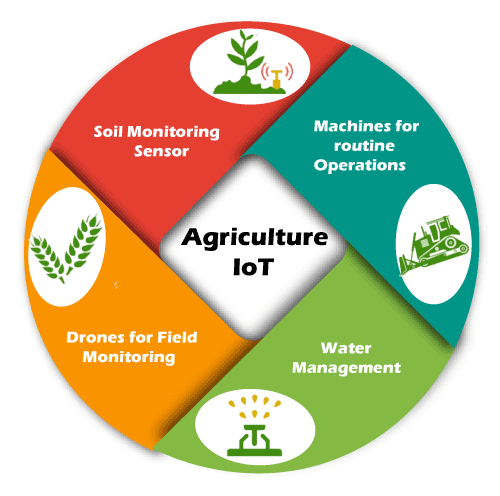IoT is a network of things connected via the internet and enabled with sensors, software, and network connectivity that enables these things to collect and exchange data. While the Internet of Things (IoT) is still in an early phase of development, it has the potential to revolutionize the way we live, work, and play. One of the main sectors utilizing IoT technology is the smart farming industry.
This blog will look at what IoT means for smart farming and how we can use it to help our farms run better.
What is Smart Farming?
Smart farming is an agricultural practice that uses IoT technologies to streamline various farming processes. By relying on data collected by IoT sensors, farmers can make real-time decisions that improve various aspects of their work – from livestock management to crop production.
IoT in farming helps save time, money, and resources while producing high-quality crops and livestock. For example, by using smart agriculture sensors to monitor the state of crops, farmers can reduce the number of pesticides and fertilizers needed to reach optimal efficiency.
But why should you consider using IoT in farming in the first place? What are the benefits of IoT in farming? Let’s dive right into it.
How is IoT integral to smart farming? (benefits)
IoT technologies can potentially bring about major transformations in farming and agriculture.
The following pointers describe how IoT in farming can change the game for good –
- Smart agriculture sensors produce a large volume of data, which includes information about soil, weather conditions, crops, and cattle growth. Using this information, you can track how well your business is doing, how efficient your equipment is, how well your staff is performing, and other relevant information.
- IoT technologies help in cost management and waste reduction since it offers increased control over production. If you can identify any anomalies in livestock health and crop growth, you can rectify every possibility of losing your yield. In many cases, this data-driven approach has helped farmers improve their yields by up to 15% and has helped them avoid potential pitfalls that could’ve otherwise been disastrous for their crops.
- By utilizing the Internet of Things on your farm, you can better predict and control your production output and lower the risk to your business. If you know exactly how much of a crop you will harvest, you can more easily sell off all your product instead of worrying about wasted goods. Having this level of control over the internal process of your farm can provide great peace of mind and allow you to run your business more efficiently.
- IoT technologies provide better control over the product quality and harvest also allows you to set a higher standard for delivering your product.
- Increased business efficiency comes with process automation. Smart devices can automate processes in your production cycle, such as fertilization, irrigation, and pest control. This can save you time and money by optimizing your production.
The advantages of IoT in agriculture we have listed can be applied in many ways in real life. For example, sensor-based irrigation can help optimize water usage, and soil moisture sensors can be used to improve crop yield. You can also use IoT technologies to monitor livestock health and grazing patterns.
Some Use Cases of IoT in Farming
1. Climate condition monitoring
Smart agriculture gadgets are becoming increasingly popular in weather stations, which combine, various smart farming sensors. These stations are located across the field and collect data from the environment, which is stored in the cloud. Farmers can use this data to map climate conditions, choose appropriate crops, and take measures to improve crop yields (i.e., precision farming).
2. Drones in agriculture
Agricultural drones are one of the most promising advancements in Agritech, also known as UAVs (Unmanned Aerial Vehicles). They have better surveillance capabilities than airplanes and satellites to collect agricultural data. Drones can also perform many tasks that previously required human labor, such as planting crops, fighting pests and infections, agriculture spraying, and crop monitoring.
3. Predictive analytics for smart farming
The benefits of data analytics in agriculture are vast and effective, as it helps farmers predict many things crucial to the farming process: crop harvesting time, the risks of diseases and infestations, yield volume, etc. Farming is an occupation that is highly dependent on ever-changing weather conditions. But data analytics tools and precision agriculture can help make farming more manageable and predictable.
Conclusion
The Internet of Things (IoT) refers to the interconnectedness of physical objects and devices equipped with sensors and software that enable them to collect and exchange data. In recent years, the IoT has been increasingly applied to agriculture through smart farming to increase efficiency and productivity.
There are many benefits to using IoT for smart farming. Perhaps the most significant is the ability to collect vast amounts of data about crops and livestock. This data can improve yields, reduce costs and improve animal welfare. IoT can also automatically control irrigation systems, Greenhouses, and other farm equipment. This can lead to increased efficiency and productivity.








